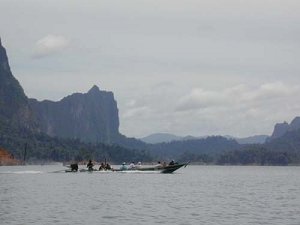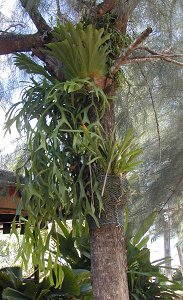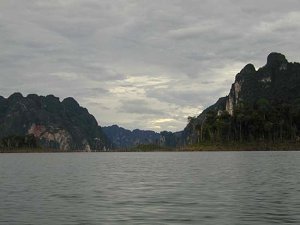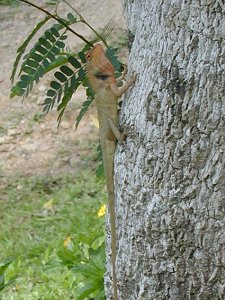|
|
matt salleh Reefs to Rainforests |
|
Khao Sok National Park- cont'd
Hornbills and Langurs
I awoke with the sun at 7 a.m. I managed to stumble over to the dock and look around with my binoculars. I spotted a large bird floating in the air and zoomed in. It was a Great Hornbill! My first sighting! I couldn’t believe it. I had only been awake 15-minutes and I had spotted a bird I was dreaming of seeing. What else would the day hold?
We were on the water by 8 a.m. for a dawn safari. We inhaled the intoxicating smells and sounds of the lake as we cast off. A troupe of Dusky Langurs danced in the treetops as we motored through the lake. A Greater Coucal sang out to us in its trademark resonating hollow voice. Around 9 a.m. the gibbons began their chorus. It started out as a low whooping noise and peaked in a high-pitched crescendo that blanketed the lake and staked a claim to defined territory. I was impressed. It was one of those moments when you realize you are only part of the experience of life… not its totality. After the gibbons performance we landed back at the raft houses. We swallowed a brief breakfast of monster mango pancakes before we loaded the long-tails again. This time we were to explore a subterranean maze of limestone caves.
Nice Staghorn Fern
A 45-minute boat ride to the opposite end of the lake and we were trekking through a tropical evergreen forest to the cave’s mouth. Epiphytes, plants that grow on top of other plants by utilizing moisture and nutrients from the air, enhanced the scenery.
Lantern Fly
By the time we reached the cave entrance we had seen more epiphyte, butterfly, rattan, and flower species than I could ever remember. As we walked, I managed to spot this lantern fly clinging to the side of a tree.
Entering the Cave
When we reached the cave we saw elephant tracks in the moist earth. They had come here in search of elephant apple, one of their favorite foods. Khao Sok is one of the few places in Thailand where Asiatic elephants still roam relatively free and safe. Tracks from fishing cats also dotted the banks of the creek that meandered into the cave’s mouth.
A few meters inside revealed cave crickets scurrying about. We discussed the delicate relationship between inhabitants of the cave ecosystem. The entrance of the cave has the most light, and therefore the most life. Fungi grow on the bat guano from the small amount of light that manages to creep in. Cave crickets feed on the fungus and are prayed upon by whip spiders, scorpion spiders and centipedes.
Delicate Food Web
Cave toads gorge on the spiders and crickets and fall prey to the cave racer, an elegant and slender snake that can scale cave walls to feast on roosting bats. The beautifully simple and delicate balance can only be maintained with little disturbance. Even the act of walking into the cave, stirs up the guano and inhibits the growth of fungi. We stick to the well-worn trail and travel single file to avoid disrupting the food web.
Subterranean
A few steps into the caves and I noticed something squishing between my toes. A leech! My first! It wasn’t as bad as I had imagined. I just pulled it off and kept on going.
We traipsed through pool and riffle in the subterranean creek. Thousand of years old stalactites and stalagmites reached for each other in their never- ending carbonaceous drippings. Each drip leached a bit more solidity until, bit by bit, they finally touched and formed a solid column. A split second touch from the oils on your fingertips can irreversibly damage hundreds or thousands of years of ‘growth’. Touching is not allowed. A few times the underground creek became neck deep and we’d dog paddle our way until we could stand up. The ice-cold water never allowed us to daydream. About an hour and a half later we emerged on the other side. Drenched from our underground explorations. Elated with that feeling you get from a nice vigorous workout. We rested and hiked two hours back to the boat. We earned our dinner that night. After eating we played Thai folksongs and chatted until we drooped wearily to bed.
Heading Out
The next morning we loaded the long-tails once more to say good-bye to Khao Sok. As we skimmed across the lake Geetha and I admired the cliffs one last time.
Bye Bye Khao Sok
While waiting to load gear into the vans, I spotted this beautiful specimen, an excellent way to end our visit to Khao Sok. Next Stop Karum waterfalls.
|





